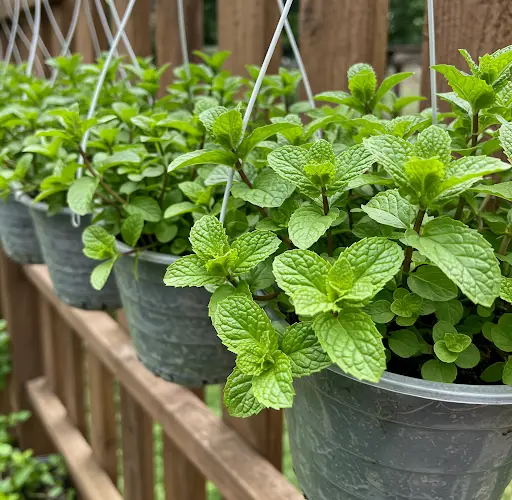Brilliant Idea: How to Grow Mint Using Recycled Plastic Bags – A Beginner’s Guide
Growing mint at home is a fantastic way to enjoy fresh, aromatic leaves for teas, cooking, and natural remedies. What’s even better? You can grow mint by recycling plastic bags, reducing waste while creating a sustainable and space-saving garden. This method is perfect for beginners, requires minimal resources, and helps repurpose plastic waste effectively.
If you’re looking for an easy, eco-friendly way to grow mint at home, follow this detailed guide.
1. Why Grow Mint in Recycled Plastic Bags?
Using plastic bags as containers for mint has several benefits:
- Eco-Friendly: Reuses plastic bags instead of sending them to landfills.
- Space-Saving: Ideal for small spaces, balconies, or urban gardening.
- Cost-Effective: Eliminates the need for expensive pots or planters.
- Portable: Plastic bags can be moved around to find the best sunlight.
- Improved Drainage: Easy to modify bags to create proper drainage for healthy roots.
2. Choosing the Right Mint Variety
Mint comes in many varieties, and you can choose based on your preference:
- Spearmint (Mentha spicata) – Common in cooking and herbal teas.
- Peppermint (Mentha × piperita) – Stronger flavor, great for medicinal use.
- Chocolate Mint – Has a subtle chocolate aroma, perfect for desserts.
- Apple Mint – Mildly fruity with soft leaves.
- Lemon Balm (Lemon Mint) – Citrusy fragrance, useful for tea and aromatherapy.
3. Materials Needed
To grow mint in plastic bags, gather the following:
- Recycled plastic bags (grocery bags, shopping bags, or soil bags)
- Mint cuttings or seedlings
- Potting soil (well-draining, nutrient-rich)
- Compost or organic fertilizer
- Scissors or a knife (for cutting drainage holes)
- A shallow tray or plate (optional, for water collection)
- Watering can or spray bottle
4. Preparing the Plastic Bags for Planting
Step 1: Select the Right Bag Size
- Use strong, durable plastic bags that can hold soil without tearing.
- If using thin grocery bags, double them for extra support.
Step 2: Create Drainage Holes
- Using scissors or a knife, poke 3–5 small holes at the bottom of the bag to allow excess water to drain.
- This prevents waterlogging and root rot.
Step 3: Reinforce the Bag
- Roll down the top edges of the bag to create a sturdier opening and improve stability.
- If needed, place the bag in a shallow tray to prevent excess water spillage indoors.
5. Planting the Mint
Growing Mint from Cuttings
- Step 1: Take a 4-6 inch mint cutting from an existing plant.
- Step 2: Remove the lower leaves, leaving only the top few.
- Step 3: Place the cutting in a glass of water for a few days until roots develop.
- Step 4: Once the roots are about an inch long, transplant into the prepared plastic bag with soil.
Growing Mint from Seedlings
- Step 1: Fill the plastic bag with potting soil, leaving 1–2 inches from the top.
- Step 2: Make a small hole in the center and place the seedling.
- Step 3: Cover the roots with soil and press gently to secure the plant.
6. Providing the Best Growing Conditions
Mint thrives in specific conditions, so make sure to provide:
- Sunlight: 4-6 hours of indirect sunlight per day. Avoid harsh direct sunlight.
- Temperature: Ideal temperature range is 60-75°F (15-24°C).
- Watering: Keep the soil consistently moist but not soggy. Water when the top inch feels dry.
- Humidity: Mint loves humidity, so mist the leaves occasionally or place a tray of water nearby.
7. Fertilizing and Maintaining Mint Plants
Mint is a low-maintenance plant but benefits from proper care:
- Fertilizing: Every 3-4 weeks, add compost tea, diluted fish emulsion, or organic fertilizer.
- Pruning: Regularly trim mint leaves to encourage bushier growth and prevent legginess.
- Repotting: If the plastic bag becomes too tight for roots, transfer mint to a larger bag or container.
8. Managing Pests and Diseases
Although mint is generally pest-resistant, keep an eye out for:
- Aphids and Spider Mites: Spray with neem oil or soapy water.
- Powdery Mildew: Improve air circulation and avoid overwatering.
- Root Rot: Ensure proper drainage by checking soil moisture regularly.
9. Harvesting Mint Leaves
Mint grows quickly and can be harvested regularly:
- First Harvest: Once the plant is 4-6 inches tall.
- How to Harvest: Pinch off the leaves or snip stems just above a leaf node.
- Frequent Harvesting: Encourages new growth and prevents flowering.
- Drying Mint: Hang harvested stems upside down in a cool, dry place for later use.
10. Repurposing Plastic Bags for Sustainability
Growing mint in recycled plastic bags is just one way to reuse plastic waste. Additional eco-friendly ideas include:
- Using plastic bags as liners for hanging baskets.
- Creating DIY vertical gardens using multiple bags.
- Recycling plastic bags into durable grow bags for other herbs and vegetables.
11. Troubleshooting Common Problems
Mint is Wilting: Likely due to under-watering or excessive heat. Keep the soil moist and provide shade if needed.
Yellowing Leaves: May indicate overwatering or poor drainage. Ensure the plastic bag has adequate holes.
Weak or Leggy Growth: Trim frequently and provide enough sunlight to encourage bushy growth.
Conclusion
Growing mint in recycled plastic bags is an innovative, beginner-friendly way to cultivate fresh herbs while reducing plastic waste. This method requires minimal space, resources, and effort, making it perfect for urban gardeners and sustainability enthusiasts. By following the steps outlined above, you’ll enjoy an endless supply of fresh, homegrown mint right from your balcony, kitchen, or garden.
Start your eco-friendly mint-growing journey today and transform everyday waste into a thriving herb garden!



